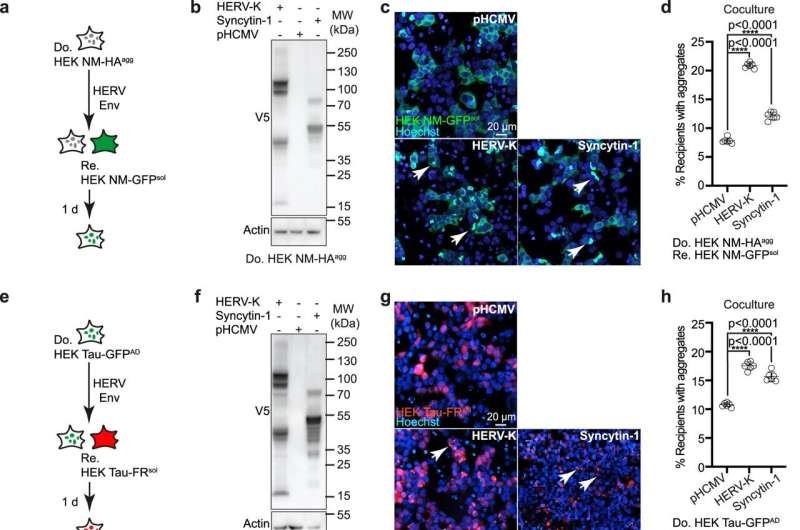This article has been reviewed according to Science X's editorial process and policies. Editors have highlighted the following attributes while ensuring the content's credibility:
fact-checked
peer-reviewed publication
proofread
'Viral relicts' in the genome could fuel neurodegeneration

Genetic remnants of viruses that are naturally present in the human genome could affect the development of neurodegenerative diseases. Researchers at DZNE have come to this conclusion based on studies of cell cultures. In their view, such "endogenous retroviruses" could contribute to the spread of aberrant protein aggregates—hallmarks of certain dementias—in the brain. Thus, these viral relicts could be potential targets for therapies. They have reported these findings in the journal Nature Communications.
It has been suspected for some time that viral infections contribute to the genesis and development of neurodegenerative diseases. Laboratory studies by DZNE scientists now suggest a mechanism that, although related to viruses, does not require infection by external pathogens. According to this study, the culprits would be endogenous retroviruses that are naturally present in the human genome.
"During evolution, genes from numerous viruses have accumulated in our DNA. Most of these gene sequences are mutated and normally muted," explained Ina Vorberg, research group leader at DZNE and a professor at the University of Bonn. "However, there is evidence that endogenous retroviruses are activated under certain conditions and contribute to cancer and neurodegenerative diseases. Indeed, proteins or other gene products derived from such retroviruses are found in the blood or tissue of patients."
Experiments with tau aggregates
Vorberg followed this trail together with colleagues from Bonn and Munich. Using cell cultures, the researchers simulated the situation in which human cells produce certain proteins from the envelope of endogenous retroviruses. Specifically, this involved HERV-W and HERV K—both viruses are present in the human genome but are usually dormant. However, studies indicate that HERV-W is activated in multiple sclerosis and HERV-K in the neurological disease amyotrophic lateral sclerosis (ALS) and in frontotemporal dementia (FTD).
Now, Vorberg's team has found that the viral proteins facilitate the transport of so-called tau aggregates from cell to cell. Tau aggregates are tiny protein clumps that occur in the brains of people affected by certain neurodegenerative diseases, including Alzheimer's disease and FTD.
"Certainly, conditions in the brain are much more complex than our cellular model system can replicate them. Nevertheless, our experiments show that endogenous retroviruses can influence the spread of tau aggregates between cells," Vorberg said. "Endogenous retroviruses would thus not be triggers of neurodegeneration, but could fuel the disease process once it is already underway."
Viral transport mediators
The current research and earlier studies by Vorberg's team suggest that viral proteins serve as transport mediators for tau aggregates because they insert into the cell membrane and into the membrane of the so-called extracellular vesicles, which are small fat bubbles that are naturally secreted by cells.
"For the transport of tau aggregates from cell to cell, we see two pathways in particular. Transfer between cells that are in direct contact, and transport within vesicles that act as cargo capsules, so to speak, and pass from one cell to another to eventually merge with it," Vorberg explained.
"In both scenarios, membranes have to fuse. Proteins from the envelope of viruses can promote this process. That's because many viruses are adapted to fuse with host cells. This happens by means of special proteins that viruses carry on their surfaces. If precisely these proteins are incorporated into the cell membrane and the membrane of extracellular vesicles, it is understandable that the tau aggregates then spread more easily."
Starting points for therapy
In the course of the natural aging process, the regulation of genes can change—originally "dormant" endogenous retroviruses could be "awakened" as a result. Indeed, the symptoms of most neurodegenerative diseases do not manifest until older age. This raises two conceivable approaches to therapy.
"On the one hand, one could try to specifically suppress gene expression, that is, to inactivate the endogenous retroviruses again. That would get to the root of the problem," Vorberg said. "But you could also start elsewhere and try to neutralize the viral proteins—for example, with antibodies."
Searching for antibodies
In the opinion of the researchers, it is likely that dementia patients with tau aggregates carry increased amounts of such antibodies. If it were possible to isolate these and reproduce them using biotechnological methods, it might be possible to develop a passive vaccine. Thus, in collaboration with DZNE colleagues in Berlin and Bonn, Vorberg's team aims to specifically search for such antibodies in patients.
In addition, the scientists are considering antiviral drugs. In cell culture, they have already found that such agents can actually stop the spread of protein aggregates. "This is another approach we intend to pursue," said Vorberg.
More information: Shu Liu et al, Reactivated endogenous retroviruses promote protein aggregate spreading, Nature Communications (2023). DOI: 10.1038/s41467-023-40632-z




















